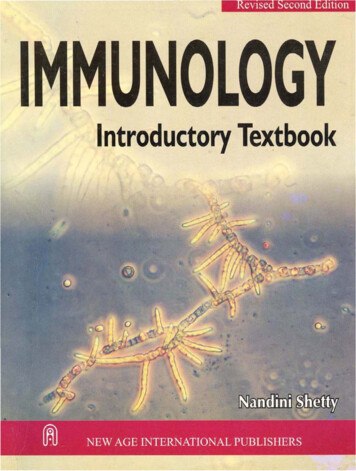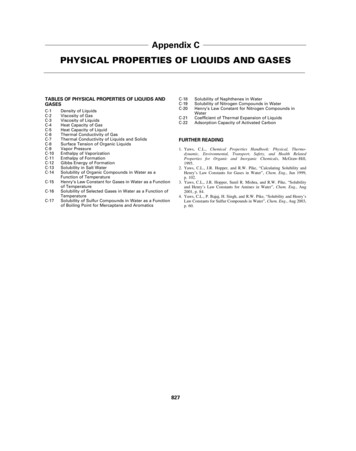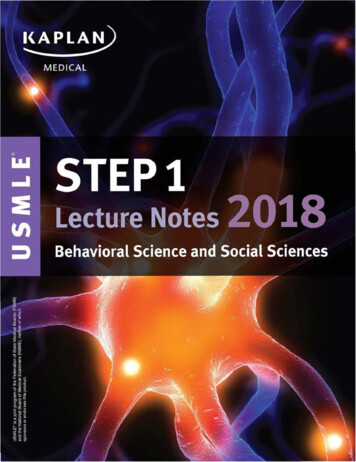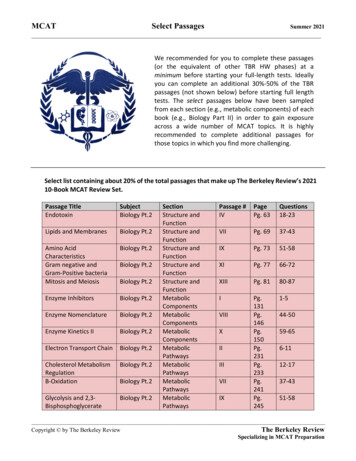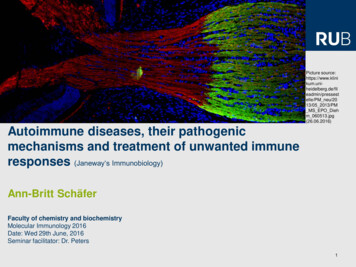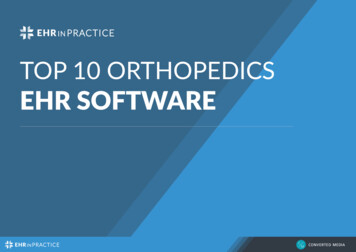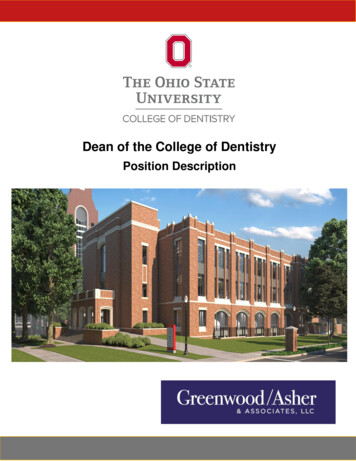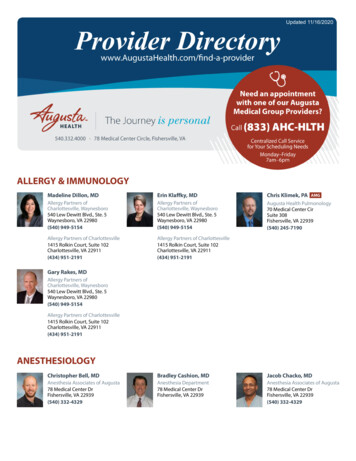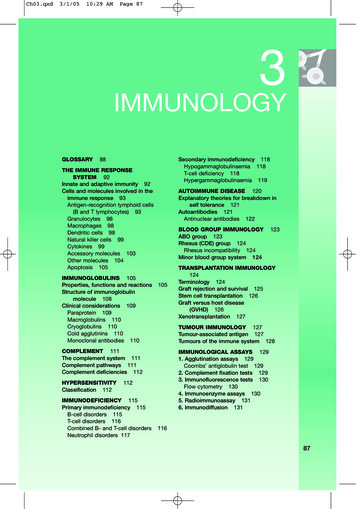
Transcription
Ch03.qxd3/1/0510:29 AMPage 873IMMUNOLOGYGLOSSARY88Secondary immunodeficiency 118Hypogammaglobulinaemia 118T-cell deficiency 118Hypergammaglobulinaemia 119THE IMMUNE RESPONSESYSTEM 92Innate and adaptive immunity 92Cells and molecules involved in theimmune response 93Antigen-recognition lymphoid cells(B and T lymphocytes) 93Granulocytes 98Macrophages 98Dendritic cells 98Natural killer cells 99Cytokines 99Accessory molecules 103Other molecules 104Apoptosis 105IMMUNOGLOBULINS 105Properties, functions and reactionsStructure of immunoglobulinmolecule 108Clinical considerations 109Paraprotein 109Macroglobulins 110Cryoglobulins 110Cold agglutinins 110Monoclonal antibodies 110AUTOIMMUNE DISEASE 120Explanatory theories for breakdown inself tolerance 121Autoantibodies 121Antinuclear antibodies 122BLOOD GROUP IMMUNOLOGYABO group 123Rhesus (CDE) group 124Rhesus incompatibility 124Minor blood group system 124105IMMUNOLOGICAL ASSAYS 1291. Agglutination assays 129Coombs’ antiglobulin test 1292. Complement fixation tests 1293. Immunofluorescence tests 130Flow cytometry 1304. Immunoenzyme assays 1305. Radioimmunoassay 1316. Immunodiffusion 131112IMMUNODEFICIENCY 115Primary immunodeficiency 115B-cell disorders 115T-cell disorders 116Combined B- and T-cell disordersNeutrophil disorders 117TRANSPLANTATION IMMUNOLOGY124Terminology 124Graft rejection and survival 125Stem cell transplantation 126Graft versus host disease(GVHD) 126Xenotransplantation 127TUMOUR IMMUNOLOGY 127Tumour-associated antigen 127Tumours of the immune system 128COMPLEMENT 111The complement system 111Complement pathways 111Complement deficiencies 112HYPERSENSITIVITYClassification 11212311687
Ch03.qxd3/1/0510:29 AMPage 883IMMUNOLOGYGLOSSARYAdaptiveimmunotherapyThe transfer of immune cells for therapeutic benefit.ADCC, antibodydependent cellularcytotoxicityA cytotoxic reaction in which the Fc receptor-bearingkiller cells recognize target cells via specific antibodies.AdhesionmoleculesCell surface molecules involved in cell–cell interaction orthe binding of cells to extracellular matrix, where theprincipal function is adhesion rather than cell activation,e.g. integrins and selectins.AdjuvantAny foreign material introduced with an antigen toenhance its immunogenecity, e.g. killed bacteria,(mycobacteria), emulsions (Freund’s adjuvant) orprecipitates (alums).AlloantibodyAntibody raised in one individual and directed againstan antigen (primarily on cells) of another individual ofthe same species.AllogeneicSee page 124.AllotypesThe protein of an allele which may be detectable as anantigen by another member of the same species.Plasma proteins are an example of antigenicallydissimilar variants.Alternative pathway The activation pathways of the complement systeminvolving C3 and factors B, D, P, H and I, which interactin the vicinity of an activator surface to form analternative pathway C3 convertase.88AnaphylatoxinsComplement peptides (C3a and C5a) which cause mastcell degranulation and smooth muscle contraction.Anchor residuesCertain amino acid residues of antigenic peptides arerequired for interaction in the binding pocket of MHCmolecules.Antigenic peptidesPeptide fragments of proteins which bind to MHCmolecules and induce T-cell activation.APCs (antigenpresenting cells)A variety of cell types which carry antigen in a form thatcan stimulate lymphocytes.ApoptosisProgrammed cell death: a mode of cell death whichoccurs under physiological conditions and is controlledby the dying cell itself (‘cell suicide’).AutologousOriginating from the same individual. 2-microglobulinA polypeptide which constitutes part of some membraneproteins including the class I MHC molecules.Bcl-2A molecule expressed transiently on activated B cellswhich have been rescued from apoptosis.CD markers(cluster ofdifferentiation)Used as a prefix (and number). Cell surface moleculesof lymphocytes and platelets that are distinguishablewith monoclonal antibodies, and may be used todistinguish different cell populations.
Ch03.qxd3/1/0510:29 AMPage 893Cell adhesionmolecules (CAMs)A group of proteins of the immunoglobulin supergenefamily involved in intercellular adhesion, includingICAM-1, ICAM-2, ICAM-3, VCAM-1, MAd CAM-1 andPECAM.Class switchingThe process by which B cells can express a new heavychain isotype without altering the specificity of theantibody produced. This occurs by gene rearrangement.Clonal selectionThe fundamental basis of lymphocyte activation inwhich antigen selectively causes activation, division anddifferentiation only in those cells which expressreceptors with which it can combine.CollectinsA group of large polymeric proteins includingconglutinin and mannose-binding lectin (MBL) that canopsonize microbial pathogens.Colony-stimulatingfactors (CSFs)A group of cytokines which control the differentiation ofhaemopoetic stem cells.Constant regionsThe relatively invariant parts of the immunoglobulinheavy and light chains, and the α, β, γ and δ chains ofthe T-cell receptor.Co-stimulationThe signals required for the activation of lymphocytes inaddition to the antigen-specific signal delivered via theirantigen receptors. CD28 is an important costimulatingmolecule for T cells and CD40 for B cells.DefensinsA group of small antibacterial proteins produced byneutrophils.Dendritic cellsDerived from either the lymphoid or mononuclearphagocyte lineages. A set of cells present in tissues,which capture antigen and migrate to lymph nodes andspleen, where they are particularly active in presentingthe processed antigen to T cells.DomainSegments or loops on heavy and light chains formed byintrachain disulphide bonds. Each immunoglobulindomain consists of about 110 amino acids.EpitopePart of an antigen that binds to an antibody-combiningsite or a specific T-cell surface receptor, and determinesspecificity. Usually about 9–20 amino acids in size.Fas ligandThe ligand that binds to the cell surface molecule Fas(CD95) which is normally found on the surface oflymphocytes. When Fas ligand binds to its receptor, celldeath (apoptosis) is triggered.Genetic restrictionDescribes the phenomenon where lymphocytes andantigen-presenting cells interact more effectively whenthey share particular MHC haplotypes.Gut-associatedlymphoid tissue(GALT)Accumulations of lymphoid tissue associated with thegastrointestinal tract.IMMUNOLOGYClass I/II restriction The observation that immunologically active cells willonly operate effectively when they share MHChaplotypes of either the class I or class II loci.89
Ch03.qxd3/1/0510:29 AMPage 90IMMUNOLOGY3HaplotypeA set of genetic determinants coded by closely linkedgenes on a single chromosome.HaptenA substance of low molecular weight which is not itselfimmunogenic, but which can bind to an antibodymolecule and produce a new antigenic determinant.Helper (TH cells)A functional subclass of T cells which can helpgenerate cytotoxic T cells and cooperate with B cellsin the production of antibody responses. Helper cellsrecognize antigen in association with class IImolecules.HeterologousOriginating from a different individual or different inbredline.Heterophile antigen Antigen which occurs in tissues of many differentspecies and is therefore highly crossreactive, e.g.Paul–Bunnell antigen which reacts with both sheep andbeef erythrocytes.HLASee page 36.IdiotypeUnique antigenic determinant on the antigen-bindingregion of an immunoglobulin molecule.HypervariableregionsAmino acid sequences within the variable regions ofheavy and light immunoglobulin chains and of the T-cellreceptor which show the most variability and contributemost to the antigen-binding site.ImmunoglobulinsubclassImmunoglobulin of the same class that is detectable inthe constant heavy chain region, and differs inelectrophoretic mobility and antigenic determinant, andfunction, e.g. IgG1, IgG2, IgG3 and IgG4.Immunoglobulinsupergenefamily (lgSF)Molecules which have domains homologous to thoseseen in immunoglobulins, including MHC class I and IImolecules, the T-cell receptor, CD2, CD3, CD4, CD8ICAMs, VCAM and some of the Fc receptors.IntercellularCell surface molecules found on a variety of leucocytesadhesion molecules and non-haematogenous cells which interact withleucocyte functional antigen (LFA-1); e.g. ICAM-1 (CD54),ICAM-2 (CD102) and ICAM-3 (CD50).90IntegrinsOne of the ‘families’ of adhesion molecules, some ofwhich interact with cell adhesion molecules, and otherswith components of the extracellular matrix.IsologousOriginating from the same individual or member of thesame inbred strain.IsotypeThe class or subclass of an immunoglobulin common toall members of that species. Each isotype is encodedby a separate immunoglobulin constant region genesequence that is carried by all members of a species.Killer (K) cellsType of cytotoxic lymphocyte that is able to mediateantibody-dependent cellular cytotoxicity (ADCC).Langerhans’ cellsAntigen-presenting cells of the skin which emigrate tolocal lymph nodes to become dendritic cells; they arevery active in presenting antigen to T cells.
Ch03.qxd3/1/0510:29 AMPage 913Lectin pathwayA pathway of complement activation, initiated bymannose-binding lectin (MBL) which intersects theclassical pathway.LinkagedisequilibriumThe association of two linked alleles more frequentlythan would be expected by chance.Memory cellsLong-lived lymphocytes which have already beenprimed with antigen but have not yet undergoneterminal differentiation into effector cells. They reactmore readily than naïve lymphocytes when restimulatedwith the same antigen.Mixed lymphocytereaction (MLR)Proliferative response when lymphocytes from twogenetically different (i.e. allogeneic) persons are mixedin cell culture. A vital test in matching donor andrecipient prior to bone marrow transplantation.IMMUNOLOGYLeucocyteA group of three molecules (LFA-1 (CD11a/CD18),functional antigens LFA-2 (CD2) and LFA-3 (CD58)), which mediate(LFAs)intercellular adhesion between leucocytes and othercells in an antigen non-specific fashion.Mucosa-associated Lymphoid tissue associated with the bronchial tree,lymphoid tissuegastrointestinal tract and other mucosa.(MALT)Natural killer(NK) cellType of cytotoxic lymphocyte that has the intrinsicability to recognize and destroy virally infected cells andsome tumour cells. Specializes in killing cells thatexpress little or no MHC molecule.NfkBA transcription factor which is widely used by differentleucocyte populations to signal activation.PerforinA granule-associated molecule of cytotoxic cells,homologous to complement C9. It can form pores onthe membrane of a target cell.Reactive l metabolites produced by phagocytic cells,including hydrogen peroxide, hypophalites and nitricacid.SelectinsThree adhesion molecules, P-selectin (CD62P),E-selectin (CD62E), and L-selectin (CD62L) involved inslowing leucocytes during their transit through venules.SuperantigensAntigens (often bacterial, e.g. staphylococcalenterotoxins) which bind to the MHC outside thepeptide-binding groove and stimulate all or most of theT cells bearing particular T-cell receptor V regions.Antigens must normally be processed in order to triggerthe T-cell receptor. Superantigens are not processed butbind directly to class II and Vβ.Suppressor (TS)cellFunctionally defined populations of T cells which reducethe immune responses of other T cells or B cells, orswitch the response into a different pathway to thatunder investigation.SyngeneicGenetically identical or closely related, so as to allowtissue transplant.91
Ch03.qxd3/1/0510:29 AMPage 92IMMUNOLOGY3TAP transportersA group of molecules which transport proteins andpeptides between intracellular compartments.T-cell receptor(TCR)The T-cell antigen receptor consists of either anαβ dimer (TCR-2) or a γδ dimer (TCR-1) associated withthe CD3 molecular complex.T-dependentantigensRequire recognition by both T and B cells to produce animmune response.T-independentantigensCan directly stimulate B cells to produce specificantibody.TitreThe highest dilution of a given substance, e.g. antibody,that will still produce a reaction with another substance,e.g. antigen.Toll receptorsA group of evolutionarily ancient cell surface molecules,e.g. the IL-1 receptor, some of which are involved intransducing signals for inflammation.Transforminggrowth factors(TGFs)A group of cytokines, identified by their ability topromote fibroblast growth, that are alsoimmunosuppressive.Tumour necrosisfactor (TNF)See page 101.THE IMMUNE RESPONSE SYSTEMINNATE (NON-SPECIFIC) AND ADAPTIVE (ACQUIRED) IMMUNITY(Fig 3.1 and Table 3.1)The innate component functions as a first line of defence and involvesantigen-independent mechanisms. The adaptive component results fromantigen-dependent activation, proliferation and differentiation (clonal expansion)of lymphocytes. It takes longer to mobilize but confers specificity and exhibitsmemory. The two are functionally interrelated in several critical ways, e.g.through cytokines and complement ocessing oglobulinTHB cellCytokinesViralinfectionTCTHTarget cellsINNATE (non-specific)92ADAPTIVE (acquired)Fig. 3.1 Innate and acquired immunity.APC antigen presenting cells, TH helper T cells, TC cytotoxic T cells.
Ch03.qxd3/1/0510:29 AMPage 933Table 3.1 Differences between the innate and adaptive immune response systemsInnate (non-specific system)Adaptive (acquired system)Components1. Cell-mediated response effected by T cells2. Humoral immune response effected by B cellsProperties1. Rapid: responds within minutes to infection2. No antigenic specificity, i.e. the samemolecules and cells respond to arange of pathogens3. No memory, i.e. the response does notchange after repeated exposureProperties1. Slow: response over days to weeks2. Antigenic specificity i.e. each cell isprogrammed genetically to respond to asingle antigen3. Immunological memory, i.e. on repeatedexposure the response is faster, stronger andqualitatively different4. Diversity: ability to recognize and respond toa vast number of different antigens5. Self/non-self recognition: i.e. lack of response(tolerance) to self-antigens but response toforeign antigens4. Preformed or rapidly formed componentsIMMUNOLOGYComponents1. Anatomical and physiological barriers2. Inflammatory response with leakage ofantibacterial serum proteins (acute-phaseproteins) and phagocytic cells3. Phagocytosis by neutrophils andmacrophages4. Complement systemCELLS AND MOLECULES INVOLVED IN THE IMMUNE RESPONSE1. Antigen-recognition lymphoid cells(B and T lymphocytes)2. Granulocytes3. Macrophages4. Dendritic cells5.6.7.8.Natural killer cellsCytokinesAccessory moleculesOther molecules1. ANTIGEN-RECOGNITION LYMPHOID CELLS (B AND T LYMPHOCYTES)B lymphocytes (see also Immunoglobulins, p. 105).Functions:Humoral immunity – antibody production; control ofpyogenic bacteria; prevention of blood-borne infections;neutralization of toxins.% of total12%; mainly fixed.lymphocytes:Site of production:Produced in germinal centre of lymph nodes andspleen.Assessment ofSerum specific immunoglobulin levels; specificfunction:antibodies; immunoglobulin response to pokeweedmitogen; endotoxin and EBV.T lymphocytesFunctions:% of totallymphocytes:Site of production:Cell-mediated immunity; protection against intracellularorganisms, protozoa and fungi; graft rejection; control ofneoplasms.70–80%; mainly circulating; long-lived memory cells.Produced in paracortical region of lymph nodes andspleen.93
Ch03.qxd3/1/0510:29 AMPage 943IMMUNOLOGYAssessment offunction:Delayed hypersensitivity skin reactions using candida,mumps and purified protein derivative (PPD); activesensitization with dinitrochlorobenzene (DNCP);lymphocyte transformation: mitogenic response tophytohaemagglutinin (PHA) and concanavalin-A; mixedlymphocyte reaction (MLR); lymphokine release.T-cell surface phenotypes identified by reaction withmonoclonal Abs (Table 3.2 and Fig. 3.2).Identified by:T cells express either γδ or αβ T-cell receptors. αβ T cells are divided intoCD4 and CD8 subsets. T cells are further subdivided into TH1 and TH2 on thebasis of their cytokine profiles (Fig. 3.3). Table 3.2 T-cell surface antigens and CD markers (see also Fig. 3.3)Surface antigen% of peripheral T cellsHLA restrictionFunctionT3 (CD3)T4 (CD4)T8 (CD8)All6535Class II MHCClass I MHCTH and TDH cellsTS and TC cellsCD, cluster of differentiation; MHC, major histocompatibility complex; TH helper T cells;TDH, delayed hypersensitivity T cells; TS suppressor T cells; TC, cytotoxic T cells (see below).TCRCD3CD4CD2AllT cellsCD28THTCCD5CD8CD7Fig. 3.2 T-cell CD markers.γδTαβTCD4TH194Fig. 3.3 T-cell subsets.CD8TH2
Ch03.qxd3/1/0510:29 AMPage 953T-cell subpopulationsIMMUNOLOGYRegulatory and effector T cellsRegulatory cells:1. TH helper T cells CD4 : recognize antigen by means of the T-cell receptorsin association with macrophage receptors. Produces cytokines and helpsgenerate cytotoxic T cells and cooperates with B cells in production ofantibody responses. Recognizes antigen in association with class II MHCmolecules on the surface of antigen-presenting cells.2. TS suppressor T cells: interfere with the development of an immuneresponse of other T cells or B cells, either directly or via suppressor factors.Effector cells:3. TC cytotoxic T cells CD8 : regulate the immune response and can lysetarget cells, e.g. viral or tumour antigens expressing antigen peptidespresented by MHC class I molecules on the surface of all nucleated cells.Interleukin-2 (IL-2) is responsible for the generation of cytotoxic T cells.4. TDH delayed hypersensitivity T cells: release mediators that cause aninflammatory response attracting macrophages, neutrophils and otherlymphocytes to the site.Other selected important CD markersCD28: Present in highest amounts in activated T cells. It is a T-cellcostimulatory molecule which plays a major role in T cell activation.CD45RA: An isoform of CD45 associated with active T cells that respondpoorly to recall antigen.CD45RO: An isoform associated with memory T cells. Responds well torecall antigen.CD95: Also known as Fas, binds Fas ligand and mediates apoptosis ofactivated T cells.TH1 and TH2 populations(Fig. 3.4) CD4 MHC class II-restricted T cells can also be subdivided into TH1 and TH2populations based on their profiles of cytokine production. The TH1 profile is associated with production of IL-2, tumour necrosis factor(TNF)-β and interferon (IFN)-γ and is driven by IL-12. The TH2 profile is associated with IL-4, IL-5, IL-6 and IL-13 and is driven byIL-10. TH1 cytokines are involved in helping cell-mediated immunity and the TH2cytokines mediate humoral immunity. TH1 cells can downregulate TH2 cells and vice versa.T-cell antigen receptor (TCR) (Fig. 3.5)TCR complex comprises a disulphide-linked heterodimeric glycoprotein thatenables T cells to recognize a diverse array of antigens in association with MHCmolecules. It consists of α and β subunits or occasionally γ and δ subunits. It isassociated at the cell surface with a complex of polypeptides knowncollectively as CD3 which is required for activation of T cells. Consists of α, β subunits or, less commonly, γ or δ subunits. Differences in the variable regions of the TCR subunits account for thediversity of antigenic specificity among T cells. TCRs only recognize antigenic peptides bound to class I or class II MHCmolecules. T cells can be divided into different subsets based on the expression of oneor other T-cell receptor (TCR-1 or TCR-2).95
Ch03.qxd3/1/0510:29 AMPage 963TH1 and TH2 cellsTH0IMMUNOLOGYBacterial'Primed' CD4 cell IL-10 IL-12TH1TH2InhibitionIL-2IFN-γIL-4, 1 effects Reinforces early local responses Promotes cell-mediated cytotoxic responses Mediates type IV delayed type hypersensitivityTH2 effects Activates later systemic responses Promotes humoral antibody responses Promotes allergic type 1hypersensitivity responses Limits inflammatory responsesFig. 3.4 Involvement of TH1 and TH 2 cells in immunity.TCR(α/β or γ/δ)CD3subunitsζζγCFig. 3.5 T-cell receptor (TCR) complex.96CD3subunitsVδε
Ch03.qxd3/1/0510:29 AMPage 973 TCR-1 cells are thought to have a restricted repertoire and to be mainlynon-MHC restricted. TCR-2 cells express either CD4 or CD8 which determines whether they seeantigen in association with MHC class II or I molecules.Infected cellIMMUNOLOGYT-cell recognition of an antigen T cells recognize antigens that originate within other cells, such as viralpeptides from infected cells. T cells bind specifically to antigenic peptides presented on the surface ofinfected cells by molecules encoded by the MHC. The T cells use their specific receptors (TCRs) to recognize the uniquecombinations of MHC molecule plus antigenic peptide (Fig. 3.6).MHC moleculepresents peptideAntigen peptide boundto MHC moleculeT-cell receptorrecognizes MHCand peptideEffectorCD8T cellCytolysis of virallyinfected cellFig. 3.6 T-cell recognition of antigen.Summary Class I MHC pathway: presents antigenic peptides derived fromintracellular viral, foreign graft and tumour cell proteins to CD8 cells. Class II MHC pathway: presents antigenic peptides derived from internalizedmicrobes to CD4 cells. The stages in the recognition and processing of a virally infected cell by acytotoxic CD8 T cell are:1. Entry of virus into the target cell.2. Replication of the virus.3. Processing of viral proteins to generate antigenic determinants whichassociate with MHC (HLA) class I molecules.4. Presentation of the antigen–HLA complex for recognition by a specific CD8cytotoxic cell, with killing of the infected cell.5. The naïve T cells that emerge from the thymus are pre-cytotoxicT lymphocytes, and require further activation and differentiation to becomethe effector T cells that lyse virally infected target cells and tumour cells.The T-cell subset γδ TCR-expressing T cells are a minor population ( 5%) of all T cells andare a separate lineage from the αβ T cell that differentiates into CD8 andCD4 cells.97
Ch03.qxdIMMUNOLOGY33/1/0510:29 AMPage 98 The γδ TCR recognizes antigen differently without processing or presentationon a MHC class I or class II molecule, e.g. non-peptide antigen such asbacterial cell wall phospholipids. They act as part of the first line of defence, recognizing pathogens mainly inthe skin and gut. They can secrete cytokines, help B cells, activate macrophages and lysevirally infected cells.2. GRANULOCYTES Neutrophils (PMNs): strongly phagocytic cells important in controllingbacterial infections. Eosinophils: weakly phagocytic: main role is in allergic reactions anddestruction of parasites. Basophils and mast cells: non-phagocytic granulocytes that possesscell-surface receptors for IgE. Mediate allergic and antiparasitic responsedue to release of histamine and other mediators.3. MACROPHAGESMonocytes are released from the bone marrow, circulate in the blood and entertissues, where they mature into macrophages.Functions1. Phagocytose microbes.2. Secrete inflammatory mediators and complement components.3. Present antigen associated with class II MHC and CD4 cells.4. Secrete numerous cytokines that promote immune responses (IL-1, TNF-α,IL-6 and IL-12).Phagocytosis of microbes by neutrophils and macrophages1. Bacteria are opsonized by IgM, IgG, C3b and C4b, promoting theiradherence and uptake by phagocytes.2. The killing activity of neutrophils and macrophages is enhanced by highlyreactive compounds: oxygen-dependent (hydrogen peroxide H2O2,superoxide anion, hydroxyl radicals, hypochlorous acid and nitric oxide(NO)) and oxygen-independent (acids, lysozyme–degrades, bacterialpeptidoglycan, defensins (damage membranes), lysosomal proteases,lactoferrin (chelates iron). Their formation by NADPH oxidase, NADHoxidase or myeloperoxidase is stimulated by a powerful oxidative burstfollowing bacterial phagocytosis.4. DENDRITIC CELLSFound in various tissues, e.g. Langerhans cells of the skin, peripheral blood andlymph glands.Functions1. Antigen-presenting cells: efficient at presenting antigen to both CD4 andCD8 cells.2. Have phagocytic activity and release cytokines.98
Ch03.qxd3/1/0510:29 AMPage 993Antigen-presenting cells Include macrophages, monocytes or their derivatives (microglial cells, Kupffercells and skin Langerhans cells). Characterized by their ability to phagocytose, internalize and process antigen. Possess Ia antigen, Fc receptors and C3b receptors and produce interleukin 1.Functions1. Similar function to lymphocytes – kill virus-infected cells and some tumourcells, and produce cytokines.2. Recognition of target differs from lymphocytes – they do not bind MHC, anda carbohydrate receptor selects target. NK cells express two major classesof inhibitory receptors for MHC molecules: lectin-like receptors of the CD94family and immunoglobulin superfamily molecules (KIRs).3. Act rapidly, and constitute an early antiviral defence.4. Identified by: Fc receptor for IgG.5. Previously referred to as large granular lymphocytes (IGL) because of theirappearance.IMMUNOLOGY5. NATURAL KILLER (NK) CELLSMechanisms of NK cell killing Direct cytotoxicity involving contact with target cell and lysis byperforin-mediated mechanism similar to that used by TC cells, except it isantigen independent and non-MHC restricted. Antibody-dependent cellular (ADCC) cytotoxicity. Binding of Fc receptors onNK cells to antibody-coated target cells initiates killing. (Neutrophils,eosinophils and macrophages also exhibit ADCC).6. CYTOKINES (Fig. 3.7) Small protein signalling molecules (usually glycoproteins) of relatively lowmolecular weight. They regulate important biological processes: proliferation and differentiation,growth inhibition, apoptosis, chemotaxis and chemokinesis, resistance toviral infection, induction of cytotoxic effector cells, induction of phagocytes,promotion of intercellular adhesions and regulation of adhesion toextracellular matrix. Many cytokines act by causing aggregation of receptors at the cell surface,which leads to activation of second messenger system. The main cytokines are interferons, interleukins, tumour necrosis factor,growth factors, colony stimulating factors and chemokines.1. Interferons (IFNs) (Table 3.3)These glycoproteins are produced by virus-infected cells. Three species of interferon:1. Alpha-interferon (IFN-α) produced by human leucocytes2. Beta-interferon (IFN-β) produced by human fibroblasts3. Gamma-interferon (IFN-γ) produced by human T lymphocytes in responseto antigenic stimulation. Properties:1. Prevent viral replication2. Antitumour activity3. Activate macrophages and natural killer (NK) cells.99
Ch03.qxd3/1/0510:29 AMPage 1003IMMUNOLOGYPathogen/antigenInfectedcellAPCBT helperT cytotoxicprecursorPlasmacellT cytotoxicIMMUNOGLOBULINSCYTOKINESEffective at long-range(soluble or particulate target)LYTIC MEDIATORSEffective at close-range(mainly at cell surface)Fig. 3.7 Interrelationship of immune cell populations.APC antigen-presenting cell.Table 3.3 Interferons (IFNs)100CytokineImmune cellsInduced byImmunological effectsIFN-α,-βT and B cells, monocytesor macrophagesMainly viruses; alsosome bacteria, protozoaand cytokinesAntiviral activityStimulation ofmacrophages andlarge granularlymphocytes (LGL)Enhanced HLA (MHC)class I expressionIFN-γT cells and NK cellsRecognition of antigenby T-cell receptorAntiviral activityStimulation ofmacrophages andendotheliumEnhanced HLA (MHC) class Iand class II expressionSuppression of TH 2 cells
Ch03.qxd3/1/0510:29 AMPage 1013IMMUNOLOGY2. Interleukins (ILs) (Table 3.4)These cytokines stimulate proliferation of T helper and cytotoxic cells and B cells.Interleukin-1 (IL-1) is a central regulator of the inflammatory response. Synthesized by activated mononuclear phagocytes. IL-1β is secreted into the circulation and cleaved by interleukin-1β convertingenzyme (ICE). IL-1β levels in the circulation are only detectable in the following situations:after strenuous exercise, in ovulating women, sepsis, acute organ rejection,acute exacerbation of rheumatoid arthritis. Acts in septic shock by increasing the number of small mediator moleculessuch as PAF (platelet-activating factor), prostaglandins and nitric oxide whichare potent vasodilators. The uptake of oxidized low density lipoproteins (LDL) by vascularendothelial cells results in IL-1 expression which stimulates the productionof platelet-derived growth factor. IL-1 is thus likely to play a role in theformation of the atherosclerotic plaque. IL-1 has some host defence properties, inducing T and B lymphocytes, andreduces mortality from bacterial and fungal infection in animal models.Interleukin-2 (IL-2) is also known as T-cell growth factor. Induces proliferation of other T lymphocytes; generates new cytotoxic cells,and enhances natural killer cells.Table 3.4 Interleukins (ILs)CytokineImmune cellsImmunological effectsIL-1α, βMonocytes/macrophages,dendritic cellsActivation of T and B cells, macrophages,and endotheliumStimulation of acute phase responseIL-2TH1 cellsProliferation and/or activation of T, B and LGLIL-4TH 2 cells, macrophages, mastcells and basophils, bonemarrow stromaActivation of B cellsDifferentiation of TH 2 cells and suppressionof TH1 cellsIL-5TH 2 cells, mast cellsDevelopment, activation and chemoattractionof eosinophilsIL-6TH 2 cells, monocytes ormacrophagesActivation of haemopoietic stem cellsDifferentiation of B and T cellsProduction of acute phase proteinsIL-8T cells, monocytes,neutrophilsChemoattraction of neutrophils, T cells, basophilsActivation of neutrophilsIL-10TH 2 and B cells, macrophagesSuppression of macrophage functions and TH1 cellsActivation of B cellsIL-12Macrophages, dendriticcells, B cellsSuppression of macrophage functions and TH1 cellsActivation of B cells3. Tumour necrosis factor (TNF) (Table 3.5) The
Cold agglutinins 110 Monoclonal antibodies 110 COMPLEMENT 111 The complement system 111 Complement pathways 111 Complement deficiencies 112 HYPERSENSITIVITY 112 . Minor blood group system 124 TRANSPLANTATION IMMUNOLOGY 124 Terminology 124 Graft rejection and survival 12
